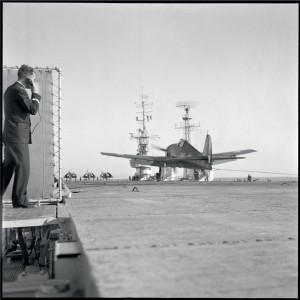At the end of the Second World War, the French army, navy and military industry had to be rebuilt. Having worked as an air force photographer since 1944, André Branlard documented the transformation of these two armed forces and illustrated the role of the USA in their rebirth.
Through NATO and the policy of containment, which aimed to check the spread of communism, the Americans provided a huge amount of support for French action in Indochina. In particular, they supplied large quantities of modern equipment through the Military Assistance Program. The USS Langley aircraft carrier was loaned to France between 1951 and 1963, serving in French Indochina under the name of La Fayette.
 F-84 Thunderjet aircraft were also supplied to the air force — André Branlard photographed the presentation ceremony with General Eisenhower — and these were used in 1956 during the Suez crisis, when the USA demanded that the Franco-British alliance end hostilities. André Branlard also showed how this support contributed to the recovery of the nation’s industry by photographing Mystère IV aircraft, built by Dassault but financed by the USA, just after the first models were delivered to the Cambrai
F-84 Thunderjet aircraft were also supplied to the air force — André Branlard photographed the presentation ceremony with General Eisenhower — and these were used in 1956 during the Suez crisis, when the USA demanded that the Franco-British alliance end hostilities. André Branlard also showed how this support contributed to the recovery of the nation’s industry by photographing Mystère IV aircraft, built by Dassault but financed by the USA, just after the first models were delivered to the Cambrai  air base.
air base.
Finally, his images of the construction of the Clemenceau aircraft carrier represent a dual symbol of the rebirth of a modern navy structured around carrier battle groups and of an independent national industry, which made it possible for France to withdraw from NATO’s integrated military command, in 1966.
Photos credits : © ECPAD / André Branlard




Ajouter un commentaire